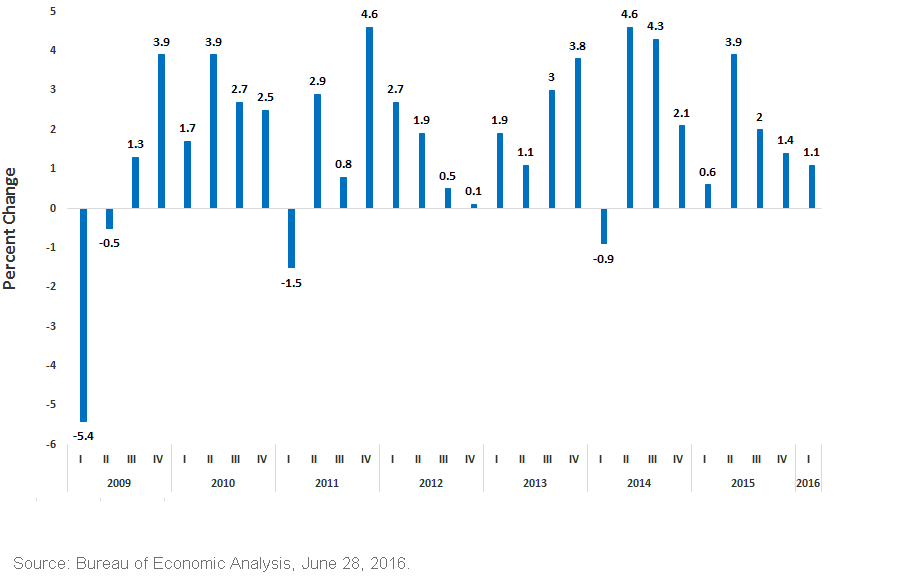It’s Not the End of the World as We Know It


 After a bit of a slowdown to begin the year, it looks as if consumer spending could put in a robust performance, providing the lion’s share of positive contribution for Q2. This is an important consideration, as the personal consumption expenditure component will more than likely continue to be the key cylinder in the economic engine. Admittedly, the negative headlines regarding Brexit and the attendant volatility in the financial markets could have an impact on consumer sentiment, but we feel that future household spending plans will continue to provide support for the overall economy.
Let’s take a look at some of the other cylinders of the “GDP engine.” When the discussion turns to Brexit’s negative effects on domestic output, the consumer is rarely mentioned. Instead, most of the attention is on trade, or net exports. According to the latest year-to-date data from the Bureau of Economic Analysis, the UK accounts for roughly 4% of U.S. exports, while the European Union (ex-UK) tally is around 15%. Thus, any adverse repercussions on demand from those two areas could definitely impact U.S. net exports in a negative way and could potentially be added to by a strong U.S. dollar. Another important component to look at is gross private domestic investment. Due to the plunge in energy prices that began in late 2014 and hit its nadir earlier this year, along with the attendant pullback in mining and drilling activity as well as reduced rig counts, business fixed investment has suffered. To illustrate this impact, the sector has produced three consecutive quarters as a negative contributor. With oil prices back from their 2016 depths and appearing to stabilize, at worst, the investment component should not act as the same type of drag on the overall economy in the quarters ahead. Recent data on manufacturing activity has also been better than expected: in June, the closely watched ISM Manufacturing Index rose to its highest level in 16 months.
Conclusion
A major concern following the Brexit vote was the potential for a tightening in financial conditions. However, as of this writing, this fear has not materialized. In fact, the sizable decline in U.S. Treasury yields over the last few weeks has been akin to a “Fed easing” in monetary policy. While some slowing in H2 real GDP should not be ruled out, at this point there appear to be no ominous clouds on the horizon.
After a bit of a slowdown to begin the year, it looks as if consumer spending could put in a robust performance, providing the lion’s share of positive contribution for Q2. This is an important consideration, as the personal consumption expenditure component will more than likely continue to be the key cylinder in the economic engine. Admittedly, the negative headlines regarding Brexit and the attendant volatility in the financial markets could have an impact on consumer sentiment, but we feel that future household spending plans will continue to provide support for the overall economy.
Let’s take a look at some of the other cylinders of the “GDP engine.” When the discussion turns to Brexit’s negative effects on domestic output, the consumer is rarely mentioned. Instead, most of the attention is on trade, or net exports. According to the latest year-to-date data from the Bureau of Economic Analysis, the UK accounts for roughly 4% of U.S. exports, while the European Union (ex-UK) tally is around 15%. Thus, any adverse repercussions on demand from those two areas could definitely impact U.S. net exports in a negative way and could potentially be added to by a strong U.S. dollar. Another important component to look at is gross private domestic investment. Due to the plunge in energy prices that began in late 2014 and hit its nadir earlier this year, along with the attendant pullback in mining and drilling activity as well as reduced rig counts, business fixed investment has suffered. To illustrate this impact, the sector has produced three consecutive quarters as a negative contributor. With oil prices back from their 2016 depths and appearing to stabilize, at worst, the investment component should not act as the same type of drag on the overall economy in the quarters ahead. Recent data on manufacturing activity has also been better than expected: in June, the closely watched ISM Manufacturing Index rose to its highest level in 16 months.
Conclusion
A major concern following the Brexit vote was the potential for a tightening in financial conditions. However, as of this writing, this fear has not materialized. In fact, the sizable decline in U.S. Treasury yields over the last few weeks has been akin to a “Fed easing” in monetary policy. While some slowing in H2 real GDP should not be ruled out, at this point there appear to be no ominous clouds on the horizon.
Important Risks Related to this Article
Foreign investing involves special risks, such as risk of loss from currency fluctuation or political or economic uncertainty.
Fixed income investments are subject to interest rate risk; their value will normally decline as interest rates rise. In addition, when interest rates fall, income may decline. Fixed income investments are also subject to credit risk, the risk that the issuer of a bond will fail to pay interest and principal in a timely manner or that negative perceptions of the issuer’s ability to make such payments will cause the price of that bond to decline.


